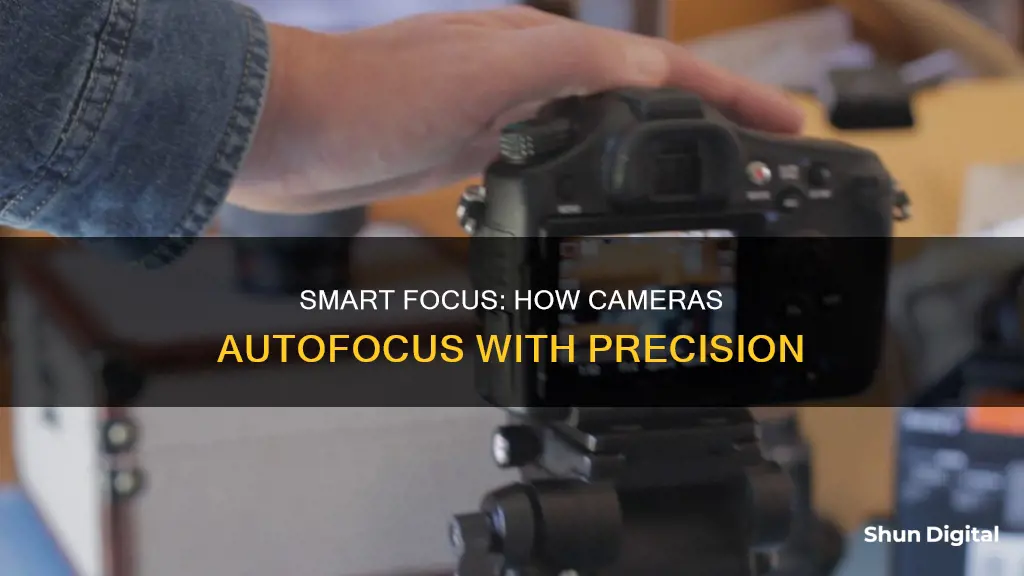
Smart Focus is a feature of modern cameras that allows the device to automatically sharpen the image and focus on a specific spot or subject with little to no input from the user. This is done through a combination of mechanical and software systems. The autofocus system in a camera works by using light to determine the correct point of focus. The autofocus system in your camera works by having light enter the camera and hit the autofocus (AF) sensor. The AF sensor then determines if the scene appears in focus. If it’s not in focus, it tells the AF motor to move the lens element(s) in the direction it ‘thinks’ will bring the scene into focus. The AF sensor tells the lens to stop focusing when the object becomes focused.
| Characteristics | Values |
|---|---|
| Camera focus | Sharpness of an object in an image |
| Autofocus | Automatic sharpening of an object in an image |
| Manual focus | Manual sharpening of an object in an image |
| Autofocus area modes | Single-point, dynamic-area, auto-area, 3D-tracking, group-area |
| Focus stacking | Combining multiple images with different focus points to create a single sharp image |
| Depth of field | Area around a subject that appears in focus |
| Deep focus | Background, mid-ground, and foreground are all in focus |
| Shallow focus | Area around the subject is not in focus |
| Soft focus | The entire image appears blurry |
| Rack focus | Changing the focus of the lens during a shot |
What You'll Learn

Manual vs autofocus
Autofocus and manual focus are two different ways of achieving the same goal: a clear shot. Autofocus allows the camera to set the focal point, while manual focus lets the user do it.
Autofocus
Autofocus is generally faster than manual focus, although its speed depends on the camera and lens type. Sports-oriented equipment, for example, is typically much faster. Autofocus has seen advancements such as tracking, which enables it to lock focus on a subject and track it through the frame. This feature is particularly useful for capturing moving subjects.
Autofocus systems rely on contrast to identify objects of interest. When this contrast is not present, such as in situations with heavy backlight, the ability of the autofocus system to focus is severely impeded. Autofocus systems also depend on light to determine where to focus, and therefore perform poorly in low-light conditions.
Autofocus is ideal for:
- Fast-moving subjects
- Beginners
- Solo shooting
- Unpredictable situations
- Moving objects
- Situations with good lighting
Manual Focus
Manual focus offers greater creative control as the user determines the focus point. This method is ideal for situations where autofocus may struggle, such as low-light conditions or taking shots through glass or fences. It is also more suitable for:
- Macro photography
- Landscape photography
- Still images
- Shallow depth of field
- Complex focus bracketing
- Scenes with many objects
- Precise focusing
The choice between autofocus and manual focus depends on the photographer's needs and shooting conditions. While autofocus is generally faster and more convenient, manual focus provides more creative control and is better suited for certain types of photography, such as macro and landscape photography.
Charging Your Fujifilm FinePix: A Step-by-Step Guide
You may want to see also

Autofocus area modes
There are several autofocus area modes available on modern DSLR and mirrorless cameras, and the specific modes available vary depending on the camera model and manufacturer. Here is an overview of some of the most common autofocus area modes:
- Single-Point AF Area Mode: This mode allows you to select a single focus point for static elements within the scene. The camera will automatically adjust focus to keep the sharpness of the image as long as you keep the subject framed over this point. This mode is best suited for still subjects or scenes where the focus point is crucial, such as landscape and portrait photography.
- Dynamic AF Area Mode: With this mode, you manually select your initial focus point, and if the subject moves, the camera uses this point and the surrounding points to maintain focus. This mode is ideal for wildlife and sports/action photography, where the subjects are in motion.
- Group AF Area Mode: Group AF area mode allows you to select a specific autofocus area with multiple autofocus points to focus on a particular subject or zone. It is useful for wildlife and sports photography, as well as group shots in portraiture.
- Auto AF Area Mode: This mode is completely automatic, allowing the camera to decide which focus points to use based on factors such as subject distances, motion, and the presence of detectable eyes. It is useful for novice photographers or situations where you need to focus on something close to the camera quickly. However, it may not be ideal when more control over the focus point is required.
- 3D AF Area Mode: This mode is available on some camera models and uses subject-to-camera distance measurement for accurate focus locking. It also employs predictive focus tracking, anticipating the subject's future position and locking focus accordingly. This mode is useful when subjects move erratically or when there is a delay between pressing the shutter and capturing the image.
The Magic Behind Camera Glass Manufacturing
You may want to see also

Continuous vs single-servo autofocus
Single-servo autofocus, also known as One Shot AF (Canon), Single-Shot AF (Sony), and AF-S (Nikon), is an autofocus system that focuses on a subject once and then stops focusing. When the shutter button is half-pressed, the camera will focus on the subject and lock on until you fully depress the shutter button to take the photo or take your finger off the button. This autofocus mode is useful for photographing static scenes or subjects that are not moving.
Continuous autofocus, also known as AI Servo AF (Canon), Continuous AF (Sony), and AF-C (Nikon), is an autofocus system that focuses continuously to keep a moving subject or photographer in focus. When the shutter button is half-pressed, the autofocus will continually change focus in order to keep the subject sharp, even if the subject or the photographer are moving. This autofocus mode is useful for tracking moving subjects and is also useful for focusing at very shallow depths when shooting handheld in very close-up situations.
Single-servo autofocus is ideal for static scenes or subjects that are not moving, while continuous autofocus is better suited for tracking moving subjects. Single-servo autofocus can also be used for action photography if the photographer is shooting with a great depth of field, while continuous autofocus can be used for still, motionless subjects if shooting with an extremely shallow depth of field.
Some photographers may prefer to use back button focus with continuous autofocus. This involves setting up the camera so that a button at the back is used for focusing, while the shutter button is only used for capturing the image. This allows photographers to use both single-servo autofocus for still subjects and continuous autofocus for moving subjects without having to switch between modes.
Different camera manufacturers may use different names for these autofocus modes, so it is important to refer to your camera's manual to understand the specific autofocus modes available on your camera.
Unlocking Macro Mode: Getting Up Close and Personal
You may want to see also

Active vs passive autofocus
There are two types of autofocus (AF) systems: Active and Passive. Each has its own advantages and disadvantages, and understanding the differences between them can help photographers choose the most suitable system for their needs.
Active Autofocus
The Active AF system calculates the distance between the camera and the subject by emitting a red beam of light towards the subject and then bouncing that light back to the camera. This system works well in low-light environments where passive AF struggles. However, it is limited to stationary subjects and only works for objects that are relatively close to the camera.
Passive Autofocus
The Passive AF system, on the other hand, does not rely on emitting a light beam to determine the distance. Instead, it uses "Phase Detection" or "Contrast Detection" to detect contrast and adjust the focus accordingly.
Phase Detection AF is commonly found in modern DSLR and mirrorless cameras. It uses an array of microlenses to split the incoming light into a pair of images. The distance between these images is measured to determine how far the subject is from the correct focus point, and this information is used to adjust the lens focus. Phase Detection AF is very fast, making it ideal for tracking fast-moving subjects.
Contrast Detection AF, on the other hand, relies on software algorithms that analyse areas of the image for edge detail. The camera scans the scene by rapidly changing the lens focus from foreground to background until the subject is sharply in focus. Due to this methodology, Contrast Detection AF is generally slower than Phase Detection AF. However, it can be more reliable and accurate in low-light conditions, which is why some cameras combine both systems in what is known as Hybrid AF.
Both Active and Passive AF systems have their strengths and weaknesses. Active AF excels in low-light conditions and with stationary, nearby subjects, while Passive AF offers more flexibility with moving subjects and is better suited for most modern DSLR and mirrorless cameras. Ultimately, the choice between the two depends on the specific needs and constraints of the photographer and their equipment.
Roku and Wyze: What's the Camera Connection?
You may want to see also

Phase detection vs contrast detection
Phase detection autofocus (PDAF) is a faster form of autofocus than contrast-detection autofocus (CDAF), which is the oldest and most popular method of autofocus found on smartphone cameras.
Phase Detection Autofocus (PDAF)
PDAF relies more on software and algorithms than on mechanically adjusting the lens position. This method of focusing is ideal for moving action and is used in wildlife or sports photography.
Around 10% of the pixels on a sensor are set aside and embedded with a phase detection photodiode, which converts light into an electric current. These pixels are made specifically for focusing and are scattered across the sensor. The camera compares the data from all the phase-detecting pixels and determines if the image is in focus. If the light waves are in phase, the picture is in focus. If not, the camera uses the data to determine the correct position of the lens to produce a sharp image.
The limitations of PDAF are that it doesn't work as well in low light and may not be able to focus accurately on low-contrast subjects. It also doesn't work in Live View or movie mode.
Contrast Detection Autofocus (CDAF)
CDAF relies on using the contrast between light and dark areas in a scene to bring the picture into focus. It achieves focus by means of trial and error, moving the focus motor back and forth in search of the highest contrast between the pixels.
CDAF is slower than PDAF but is more accurate at focusing on still subjects. It also doesn't require lens calibration. However, it struggles in low-light conditions and with moving subjects as the contrast information will change.
Hybrid Autofocus
Some smartphone cameras combine PDAF and CDAF systems to achieve faster and more accurate autofocus performance.
Mastering Rocket League Camera Settings: A Guide
You may want to see also
Frequently asked questions
Camera smart focus is an autofocus system that uses a combination of phase detection and contrast detection to ensure the image is in focus.
Camera smart focus works by dividing the incoming light into pairs of images and comparing them. The light is divided as it passes through the transparent part of the main mirror, where that area acts like a beam splitter. The two distinct images are directed downward to the autofocus sensor, where the two images are compared and their positional relationship is evaluated.
Camera smart focus is faster and more accurate than traditional autofocus systems, especially when tracking moving subjects. It also allows for more creative control over the depth of field, allowing for a greater or lesser area of the image to be in focus.
One limitation of camera smart focus is that it relies on light to function properly. In low-light conditions, the autofocus system may struggle to focus accurately. Additionally, camera smart focus may not be suitable for all types of photography, such as macro or still life photography, where manual focus is often preferred.
Most modern DSLR and mirrorless cameras have some form of smart focus capability. You can check your camera's specifications or user manual to confirm if it has this feature.







